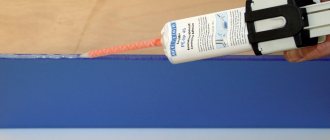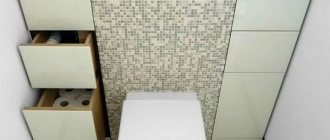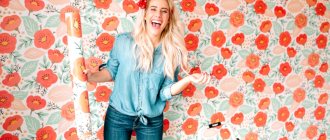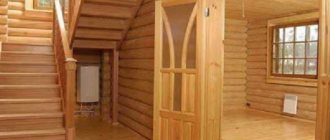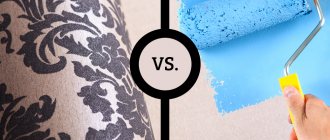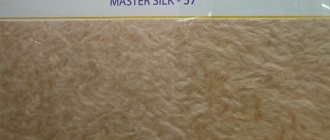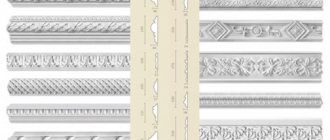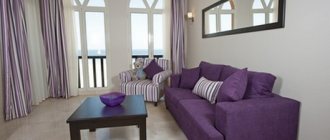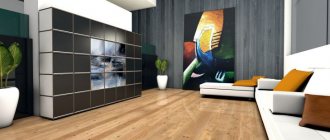Preparing walls for wallpapering
It won’t be difficult for you to properly paste wallpaper in the corners of your apartment if you follow simple rules. Initially, it is very important to prepare all the walls for wallpapering, including in the corners, and only then start applying glue to the surface. To do this, you should get rid of all the unevenness of the walls by thoroughly puttying. After it has completely dried, it must be sanded with sandpaper, because the canvas will peel off if the surface is not perfectly smooth. The last stage in preparing the walls is processing all the walls. Only when the primer has dried completely can you stick the wallpaper.
Preparing the walls
Before moving on to the question of how to glue non-woven wallpaper in the corners, you need to figure out how to properly prepare them. Let's start with the walls:
- First you need to thoroughly clean the surface of old material.
- Then (if required) beat off the tubercles and make incisions. This is necessary if the surface has previously been painted.
- At the stage of wall preparation, electrical installation is carried out, if provided.
- Carefully prime the surface.
These are mandatory steps in preparing the surface before wallpapering the corners, but the subsequent steps may differ for many. And this depends not only on the wishes of the customer or contractor, but also on the condition of the walls and corners in the room. Plastering and puttying of the surface is possible. There are three ways to plaster walls:
- Partial alignment. Using short strokes, the most “crumpled” sections of the wall are drawn out. More suitable for “quick” repairs, which are usually carried out before sale.
- Leveling the plane. It is carried out using a long rule of 2.5-3 m. A smooth (without bumps and dents) horizontal and vertical surface of the wall is achieved, and the level remains the same, that is, without changes.
- Plastering on lighthouses. Using this method, the most even (in plane and level) wall surface is achieved. In this case, gluing wallpaper in the corners is greatly simplified.
- But most often they use a combination of the last two methods: those walls that have window or door openings are usually aligned with beacons, and the rest are drawn out as a rule.
Next, one or two layers of putty are applied to the walls, having primed the surface beforehand. There are those who skip this important step, but it is recommended not to do so. Since, regardless of the leveling method, the putty can hide flaws made during the plastering process, as well as make the base uniform in color (important for some types of wallpaper) and smooth to the touch.
Features of pasting in internal corners
Pasting wallpaper on internal and external corners differs significantly, so there is no single correct solution on how to glue wallpaper in the corners. Let's take a closer look at the process of wallpapering internal corners. The wallpaper should be glued so that it turns the corner by 3 centimeters. It is very important to thoroughly coat the entire corner with glue, and in places where the roller did not reach, use a brush. The allowance should be exactly 3-5 centimeters, because if it is smaller, there is a risk that the canvas will come off after complete drying, and if, on the contrary, it is more, the strip may begin to “wrinkle” and you will have to deal with this problem by transverse cuts of the canvas itself.
The inner corner can be glued with an overlap
The next step will be to fix the second canvas to the adjacent side of the room. You need to use a tape measure or ruler to accurately measure the place where the far corner of the wallpaper will be, taking into account that the wallpaper should overlap by 2 centimeters. Standard wallpaper rolls have a width of 53 centimeters, while rolls have a width of 1 meter. Next, using a plumb line, you should draw a straight vertical line along which the canvas will be glued in the future. Only after a vertical stripe has been drawn on the wall can the second sheet of wallpaper be pasted. We press the canvas tightly with a sponge or a dry cloth to expel all the air and the wallpaper canvas fits tightly to the wall.
Straighten the wallpaper and cut off the remains
Step-by-step instructions: how to glue corners with wallpaper, initial stage
It all starts with the installation of plastic corners. They are fixed taking into account the geometry and texture of the walls in the room. To ensure that each corner is held tightly, the walls are first coated with putty.
The more tightly they are fixed, the fewer problems will arise at the pasting stage. After this, the practical implementation phase begins.
If the wall is characterized by even slight unevenness, then the strip of wallpaper is slightly trimmed in the corner. Experienced builders do not recommend covering every corner at once.
Once a certain angle for work is selected, further gluing proceeds as follows:
- Trim the required section of wallpaper;
- Carefully coat the entire width of the wallpaper with glue;
- Apply glue to the plastic corner that will be fixed to the wall;
- Fix the wallpaper on the wall;
- If it is decided to paste the wallpaper from left to right, then it is the left side that is applied to the inside of the corner;
- Carefully level the wallpaper in the corners using a roller.
During the preparatory stage, it is necessary to apply putty to the wall. The purpose of this procedure is to avoid uneven areas when fixing the wallpaper. After this, the plastic corners are fixed. The next step is to fix the left edge of the wallpaper on the inner edge of the wall corner. In order to reduce the likelihood of errors during work, it is recommended to start work in one specific corner.
Removing excess wallpaper residue on inner corners
The process of gluing wallpaper on the inner corner is almost complete; the most difficult and time-consuming stage remains. Using a ruler and a building level, we use a knife to cut two layers of wallpaper close to the corner, which we ended up with overlapping. Some craftsmen use a construction knife and an iron knife for such purposes. The excess wallpaper that was pasted second can be easily removed or will fall off onto the floor on its own.
Note!
To remove a strip of the bottom sheet, unscrew the top sheet slightly.
When the strip of the bottom sheet is completely removed, you need to re-coat the folded edge of the wallpaper with glue and stick it on the wall, pressing it with a sponge or dry rag. This method of gluing wallpaper in a corner is considered the most common, since it can be used on thin and thick wallpaper.
Tools needed when gluing wallpaper on the external corners of a room The method that is used when gluing wallpaper on the internal corners of a home is not applicable to the external corners, so the next question discussed in this article will be the question of how to wallpaper the external corners.
In order to properly and beautifully wallpaper the outer corner of the apartment, you will need the following tools:
- the wallpaper you are going to use to glue the corner;
- special wallpaper glue;
- roulette;
- a simple pencil;
- long ruler;
- plumb line;
- roller or rag;
- sharp wallpaper knife.
Wallpaper should cover the second side of the corner
How to glue non-woven wallpaper on internal corners
The first thing that needs to be said about gluing non-woven wallpaper in corners (both external and internal) is that you should not try to paste a corner with a solid sheet of wallpaper
. In other words, do not try to cover both walls adjacent to the corner with one canvas. Otherwise, there is a fairly high probability that the wallpaper will “lead” in the corner, and the resulting wrinkles will be almost impossible to smooth out without trimming, which will certainly ruin the appearance of the wallpaper. But even if this does not happen, the curvature of the corner (and unfortunately, most of the corners in our apartments are curved) will affect the position of the canvas, and since non-woven wallpaper is glued end-to-end, all subsequent canvases will also have to be glued out of level.
The correct technology for gluing non-woven wallpaper on internal corners is as follows:
- We measure the distance from the edge of the last glued canvas to the corner and add 5 centimeters to it. A panel of exactly this width will need to be prepared for sticking in the corner.
We measure the distance from the edge of the last glued canvas to the corner
Since the angle can be curved, it is better to measure the distance at three points: the bottom, middle and top of the wall. For calculations, of course, you need to take the largest of the resulting values.
- When the panel of the required width is ready, carefully coat the wall and corner with glue for non-woven wallpaper. Please note that when gluing non-woven wallpaper, the glue is applied only to the walls.
- After the canvas is pasted, you should very carefully smooth the wallpaper in the corner and on the next wall using a rubber roller or a dry cloth.
Using a rubber roller or dry cloth, smooth out the wallpaper in the corner and on the next wall.
If the wallpaper “wrinkles” in some places, you can make several horizontal cuts at a distance of 5-10 centimeters from each other.
Please note that this canvas must be glued “overlapping” the previous canvas.
- When both canvases are pasted, all that remains is to use a wallpaper knife and a metal ruler of a paint spatula to “trim the seam.” You can learn more about the “corner trimming” technology by watching the following video.
Video about corner trimming of wallpaper
It is very important to cut both wallpaper sheets “in one step”, since otherwise discrepancies may appear in the cut line.
To ensure that the cut is even and the wallpaper does not “stretch” under the knife? You need to periodically break off the dull tip of the wallpaper knife according to the marks specially applied to the blade.
- After trimming, all that remains is to remove the excess wallpaper. The top layer can be removed without problems, and the bottom layer can be removed by slightly unscrewing a small part of the top panel.
If you did everything correctly, the panels will form an almost imperceptible joint between each other, which remains to be carefully smoothed using a rubber roller.
Pasting wallpaper on external corners
Pasting wallpaper on the outer corners of the room will not be a huge task or problem if you adhere to a few basic rules and follow the instructions described below.
- We cover one of the walls near the corner with wallpaper so that the edge of the wallpaper wraps approximately 2-4 centimeters to the other side of the outer corner of the room. The width is determined depending on how even the angle is in level.
- We press the wallpaper tightly against the wall and try to expel all the air and get rid of bubbles using a sponge or clean rag.
- If folds or bubbles form during gluing, make small horizontal cuts on the canvas to get rid of these problems.
- At the next stage, we cut off the folded edge of the wallpaper with a sharp construction knife so that only a thin edge of the canvas remains on the second side of the corner.
- Next, on the second side, using a plumb line and a ruler, we determine where the far corner of the canvas will be located.
- We glue the wallpaper so that it overlaps the small edge of the wallpaper, but does not go beyond the edge of the outermost corner.
- We press the canvas against the wall and smooth it out to get rid of bubbles or wrinkles. You should also make horizontal cuts if folds appear.
Remaining wallpaper needs to be removed
External corners
Slope finishing
Oddly enough, similar protrusions are found in many rooms and spaces. These include slopes. If you are lucky and they turn out to be even, you can paste them over by wrapping the sheet tightly.
Sequence of work
It is necessary to glue wallpaper in corners with significant irregularities with a slight overlap.
We glue a strip to one of the walls so that the end is wrapped onto the protrusion by 3-4 cm.
A room with external and non-internal projections
We press this edge to the surface, but strive to ensure that it lies flat. If you have difficulty with this, you can make several cuts. Now we cut the folded end vertically, leaving only a thin edge, invisible through the second sheet.
Using a tape measure and a plumb line, we determine and mark the gluing line for the edge farthest from the protrusion; we do all this before gluing the second sheet.
The distance from this contour to the folded edge of the first sheet should be 5-6 mm less than the width of the gluing strip.
We should have a slight overlap.
Advice! If you are gluing non-woven fabrics that are of sufficient thickness, use transparent glue.
Rules for gluing wallpaper in corners
Thanks to the information presented above, we found out how to glue wallpaper in the corners. Regardless of which type of corner you are going to stick wallpaper on, there are general recommendations that you must adhere to when performing this type of finishing work:
- Firstly, keep in mind that most often the wallpaper begins to peel off from the corner, so be sure to coat it very carefully with adhesive. It is not always possible to completely coat the inner corner of an apartment with a roller, so in this case you should use a brush;
- secondly, you should not cover the corners of your apartment with solid canvases, even if you have perfect walls. There is a high probability that you will get a corner with folds, or the wallpaper on the second wall will not be level, and it is best to level it in the corners;
- thirdly, make calculations before applying wallpaper glue to the wall, since not even all professionals can paste wallpaper in the corners without clear calculations;
- fourthly, start gluing wallpaper from the corner. Previously, it was believed that wallpaper should be glued away from the window, because then the wallpaper was glued overlapping and, thus, it was possible to visually slightly hide all the joints on the wallpaper;
- fifthly, prepare the corners in advance for applying wallpaper. Try to make them as even as possible. Also keep in mind that you can apply wallpaper when the primer is completely dry, otherwise your wallpaper may quickly come off and you will have to re-glue it;
- sixth, turn off the electricity and remove all sockets before you start wallpapering. When gluing wallpaper in places where sockets are located, make a small cut according to the size of the socket cavity itself. Next, fold the cut wallpaper inward. Now the wallpaper will look neat and without cuts after you put the sockets back.
Pasting wallpaper in corners will not cause many problems and awkwardness if you know how to properly wallpaper corners. The gluing methods described in this article are applicable to all types of wallpaper: vinyl, non-woven and other types. Don’t write off wallpapering; it’s better to measure everything first, because wallpaper creates the final impression of your home and this type of finishing work must be done perfectly.
How to properly glue wallpaper in corners video:
See inaccuracies, incomplete or incorrect information? Do you know how to make an article better?
Would you like to suggest photos on the topic for publication?
Please help us make the site better!
Leave a message and your contacts in the comments - we will contact you and together we will make the publication better!
Wallpapering has been and remains the cheapest and most beautiful way to decorate walls. Beginners can master it on their own; it is also used by masters with pleasure. This is a simple and easy process that takes little time. But, as in any repair work, you should have a minimum of knowledge and master some skills, without which the result may disappoint a diligent worker. The question of how to properly paste wallpaper in the corners of a room is of concern already at the initial stage of work and requires careful preliminary preparation.
Gluing wallpaper to an uneven surface
Yes, this happens, and not so rarely. And this is perhaps the worst option for someone who doesn’t know how to hang wallpaper in the corners of a room. If you decide to “save” on the preparation of walls and corners, then you can safely forget about gluing all kinds of frescoes, photo printing or photo wallpaper, thin wallpaper of any type. Don’t even try to glue the entire wallpaper to the inner corner, that is, go around the corner in one piece.
It's better to do this:
- Start gluing from the corner of the room, and it doesn’t matter which one. The main thing is that the first strip needs to be placed on the adjacent wall by 1.5-3 cm, while carefully gluing the corner itself (all the bumps and dents).
- The first strip must be leveled (the side that does not go at an angle). It will be more convenient to do this using a laser.
- The second piece is glued from the corner with an overlap on the outlet of the first canvas, which we left earlier. The side that is farthest from the corner is set according to the level (not necessary if the canvas overlaps the door or window opening).
- Next we join two pieces of wallpaper. To do this, you need to make a vertical cut (two panels at once) using a wide spatula and a painting knife. It is more convenient to cut from top to bottom, but without lifting the knife blade from the wallpaper. After this, you need to pull out the cut strips, apply glue (if necessary) and smooth the joint with a spatula.
- It should be taken into account that if there are obvious bumps and dents on the wall, it is almost impossible to obtain a high-quality joint.
The outer corner is glued in a similar way, but with a slight difference. If the corner has not been leveled (using paint corners), then there is no point in even trying to pass it. It is better to cut the canvas at the corner and start gluing the next side with the remaining piece. The canvases are also set according to level. You can subsequently glue a decorative corner of a suitable size and color onto the corner.
Preparing corners
Even if visually the corners seem even, upon closer examination the picture turns out to be not so rosy. The slightest irregularities on the walls and a crooked corner line will cause the canvas applied to the surface to lie crookedly on the adjacent wall and cause the wallpaper to rip and unsightly creases. The next strip of wallpaper, glued end-to-end, will not lie strictly vertically, the pattern will shift - as a result, the wallpaper will have to be torn off the wall and work started again. To prevent this from happening, you must:
Pasting corners, as well as the walls themselves, should not be done “by eye”.
In order not to rack your brains once again about how to glue wallpaper in the corners of a room, you need to prepare the tools:
- spatula (it should not be wide, the optimal width is 15cm);
- plumb line (allows you to maintain a strictly vertical level of the glued strips);
- construction knife (with its help, excess pieces of wallpaper are removed quickly and accurately);
- roulette;
- pencil;
- brush;
- roller;
- scissors.
A large number of wallpapers offered for sale have to be glued end-to-end, rather than overlapping, therefore, when deciding from which angle to glue the wallpaper, it is better to focus on strict vertical lines. Since there are practically no perfectly straight corners in modern rooms, you can start gluing wallpaper from the door or window.
Method of gluing overlapping corners
The most important question that arises during the renovation process is how to glue wallpaper in the corners of rooms. Perfectly straight corners are rare. As a rule, there is a distortion, which is clearly visible on the trellis canvas in the form of folds. There are two ways to solve the problem:
Diagram of the procedure for covering an attic with duplex wallpaper.
- Stepping back from the corner by the width of the wallpaper (45-95 cm), you need to use a plumb line to draw an even line from the ceiling to the floor. This will be the place where the first sheet will go. It should be directed towards the corner. A joint will be formed there, which must be combined as much as possible with the adjacent strip. A slight overlap is allowed.
- The angle should be 1/3 of the width of the trellis. You need to start gluing wallpaper from the wider edge. When passing an uneven corner, the canvas will fold into folds. You should try to leave one unevenness, working with a plastic spatula from the edges to the middle. The fold should then be cut in two places. The excess piece is removed, and the canvas is combined into a single whole without a fold. This should be done until the glue has dried and the sheet glides easily over the surface.
When choosing the most successful method for a particular case, you need to take into account the degree of curvature of the walls, the selected pattern and the type of finishing material. If the wallpaper has a large pattern that needs to be combined, it is better to choose a combination of stripes in the corners of the room. Then the joints will not be so noticeable due to the combined print.
How to cover an outer corner?
Before gluing wallpaper with a pattern in the corners, you need to prepare a canvas of such width that it goes around the edge of the outer corner and rests a few centimeters on the wall adjacent to it. To do this, you need to measure the distance from the edge of the previous strip to the corner and add 2-3 cm to the resulting value, transfer the measurements to the wallpaper, cut off the excess, and only then start gluing the corners. An edge that has been turned around a corner may cause creases. In these places, cuts are made with a construction knife. The canvas is carefully smoothed and pressed tightly against the wall.
Advice! When using heavy wallpaper (for example, vinyl), glue is applied to both the wall and the wallpaper. To stick light (for example, non-woven) wallpaper, it is enough to grease only the wall. But in both cases, dried areas of walls and wallpaper need additional lubrication with glue.
A vertical line is drawn on the adjacent wall using a plumb line. The width of this section is determined from the corner and is equal to the width of the next panel with an addition of 0.6-1 cm. The second strip lies with its right side strictly along a vertically drawn line, and its left side overlaps the edge of the previous strip. It is necessary to carefully ensure that the motifs of the drawing on both canvases coincide. You must not only know how to glue wallpaper on the outer corner and use it skillfully, but also prevent the elements of the ornament from becoming chaotic. After the canvas is glued, you need to dip the brush in glue, coat the dried edges and press them tightly with a roller.
But, it’s one thing to figure out how to quickly stick wallpaper, another thing is to ensure that in the outer corners they don’t lift up or come off over time. It looks, to put it mildly, unaesthetic. To solve this problem, wallpaper corners are used. Long strips, reaching a length of 3 m, are quite easy to adjust to size. To do this, you can use a hacksaw. The next question arises: what is the correct way to wallpaper? They will not stick to wallpaper glue, and after using liquid nails, unsightly marks on the wallpaper cannot be avoided. Silicone sealant is ideal for these purposes.
How to wallpaper corners correctly
The technology for laying canvases on external and internal corners is different.
External
These areas are the most noticeable, so they must be covered with special care.
It's easiest if the angle is perfectly straight, but this is quite rare.
If there are defects, the process becomes more complicated. If the corner is blocked, then you will need to trim the canvas along the bend line in order to overlap one section with the adjacent one. This method is not suitable for varieties with complex patterns.
There is another way:
- The strip is glued to a section of the wall.
- Using a special spatula, the material is carefully smoothed out to fit the existing bend, and a transition is formed.
- If required, part of the laid canvas is torn off, after which the excess is driven up or down. There should be a margin on both sides.
- To adjust the pattern in case of skew, the next strip is overlapped until the pattern is aligned with a distance of 5–10 centimeters from the edge.
- Using a ruler, which serves as a stop, the applied canvases are cut exactly according to the design.
- If required, the joining areas are additionally coated with the compound.
Joining an outer corner with a trim on one of the adjacent planes is considered the most effective way of arrangement.
This method does not completely correct the misalignment, but facilitates further gluing and adjustment.
Interior
The technology for working with such a section is almost identical to the previous process, but has some nuances:
- All sides are well treated with wallpaper glue. If the composition is applied to canvases, the impregnation must also be quite thorough.
- Laying begins with the wall from which movement is carried out. The first fragment is aligned with the previous one, carefully smoothing it into the corner. To do this, the waves are driven to one side with a rubber spatula.
- The part that falls on the adjacent wall is slightly pressed.
- Further actions depend on the situation. Most often, you need to trim the existing folds in the middle and overlap the excess.
- To achieve better alignment, the edges are shortened and coated, after which the piece is placed on the main part of the canvas.
Technically, joining an internal corner is not much different from similar work on external structures, but this process is considered simpler, since internal corners are visually less noticeable.
This technology allows you to glue different types of products, but if the corner does not require trimming, installation is carried out in a standard way. To do this, the joint of both sides is made with a margin in order to level out the unevenness by adjusting and cutting at the point of alignment. This will take longer, but will get rid of the overlap in the corner.
Video tutorial: how to glue wallpaper with corners trimmed
How to cover an inner corner?
The work process is in full swing, and the vertical canvases lie flat on the wall, but the adjacent wall is getting closer and closer and you have to wonder: what does it take to hang wallpaper yourself in the inner corners? This is not as difficult as it seems at first glance, and certainly no more difficult than pasting external corners.
After the next strip is glued in front of the inner corner, you need to measure the distance from its edge on the right to the corner, add 1-2 cm to this value.
The dimensions are transferred to the next strip, it is carefully cut vertically (by eye). And for confident movement, use a spatula.
A canvas is placed on a wall carefully coated with glue. A strip of small width will also appear on the adjacent wall. You can get rid of creases using a construction knife. In the corner the canvas is very carefully pressed against the wall. A spatula is applied to the wall. The flat part is pressed against the wall and directed towards the corner. The construction knife follows the direction of the spatula. The narrow strip that ends up on the adjacent wall is carefully trimmed.
Advice! The dull parts of the construction knife must be broken off in a timely manner to avoid tears and inaccurate cutting of the wallpaper.
The part of the strip that was cut off can be used further. It is necessary to measure its width, subtract 1-2 cm from this value, transfer the dimensions to the wall, draw a vertical line. The ideally flat side of the wallpaper should lie strictly along a vertical line, and its left edge will overlap the previous strip. Using a sharp blade of a construction knife, carefully trim off the excess, as in the previous stage of work.
If novice craftsmen, when thinking about how to glue wallpaper in the corners of a room, begin to worry and rack their brains, then people who have mastered a simple technique with any wallpaper - be it heavy vinyl or light non-woven - cope with the same ease and speed. You only have to do the job correctly once, and then it starts to go wrong.
11890 0 1
Pasting internal and external corners
Non-woven wallpaper is more manageable than paper wallpaper, so it is easier to work with.
Before gluing wallpaper in the corners, you should understand that for ordinary roll material one type of glue is used, and for non-woven wallpaper a completely different one is used.
Therefore, the choice of one or another adhesive composition will depend on the type of wallpaper used.
Video:
At the same time, with paper wallpaper, glue is applied both to the finishing surface and to the wallpaper itself, and with non-woven and vinyl wallpaper - only on the wall.
The technology for gluing external corners is somewhat different from finishing internal ones.
Therefore, further we will consider how to properly wallpaper the outer and inner corners.
How to cover an inner corner?
To prevent wrinkles from forming in the inner corners after the wallpaper dries, pasting should be done not with one solid sheet, but with two sheets: one sheet on each side.
Then, just before gluing, the wallpaper needs to be bent lengthwise into two parts: one part (the main one) will cover one plane of the corner, and the second (about 40 mm wide) will go onto the adjacent side.
Next, the surface of the wall is carefully coated with glue, then, using a rubber spatula, the canvas is pressed into the corner with little force.
This should be done very carefully so as not to inadvertently damage the non-woven or paper wallpaper.
In this case, you need to watch carefully so that no air bubbles form under the wallpaper.
At the next stage, the second side of the corner is glued.
This is done with a slight overlap (about 25 mm) onto the previously glued canvas.
Next, using a plumb line, a meter ruler and a simple pencil, mark a vertical line at the overlap.
Then, according to the mark, using a stationery knife, 2 layers of wallpaper are cut simultaneously, after which the excess parts are removed.
If this procedure is done correctly, then you will definitely like the result of the work.
The most common beginner mistakes
First of all, let's look at how not to glue wallpaper. The most common mistakes newbies make are:
- Poorly prepared surface.
The level of complexity of pasting the joint of planes depends on their quality. If the apartment has crooked corners, then it will not be easy even for a specialist to complete the finishing properly. Of course, it is not always possible to make the wall joints ideal, strictly at 90 degrees, but there should be no deviations from the vertical. Therefore, spare no time and effort in preparing the surface - putty the walls or even plaster them;
Plaster corners will help you quickly and easily align external wall joints. During installation, they are leveled and then glued with plaster or putty. The price of corners starts from 30 rubles per 2 meters.
- Cutting wallpaper.
As a result of this decision, the edges of the canvases may diverge or, on the contrary, overlap each other unevenly, and accordingly, the gluing looks sloppy. Therefore, according to the technology, it is necessary to provide a slight turn onto the adjacent plane.
The exception is paper sheets that can be cut vertically. The only thing is that in this case, you first need to stick a thin strip of wallpaper onto the joint of the walls in case the joints come apart;
- Big twist.
If the joints of the walls are even, then such a mistake is not terrible, but in crooked corners a large turn will cause the strip to deviate from the vertical. As a result, all subsequent canvases will be glued crookedly;
- The canvases are not completely glued.
When gluing the canvas, many beginners do not push it all the way, as a result of which a small area located opposite the inner corner hangs in the air. This leads to the fact that over time the coating begins to peel off and even tear; - Poorly applied glue.
If wallpaper on a non-woven basis is pasted, then the glue is applied to the surface of the walls, and not the canvas. In this case, it is a mistake to work with a roller, which does not always allow you to completely coat hard-to-reach places.
Beginners are often interested in what angle should they start gluing wallpaper? If they are all level, then it doesn’t matter where you start gluing. Otherwise, start gluing from an even angle to avoid distortion of the stripes on the walls.
What is important to know?
Among the wide range of modern finishing materials, wallpaper still stands out.
Despite the fact that a large number of more functional and simpler finishing options have appeared, wallpaper continues to hold its position for many reasons.
Firstly , to decorate walls with wallpaper, it is not necessary to level the surface to perfection.
Secondly , repair work does not require special expensive equipment.
Thirdly , even a person with minimal construction skills can hang wallpaper. The main thing is to adhere to some basic rules shared by experts.
Important! A guarantee of successful wallpapering of walls is following two key recommendations. One of them concerns where to start gluing wallpaper, the other concerns how to deal with corners and other difficult places.
Let's learn how to properly install PVC panels with your own hands. Watch the video - lessons from experts.
We read about the benefits of a roll-out bed for two children here: https://hauzdecor.com/stil-i-interer/recomend/vyikatnaya-krovat-dlya-dvoih-detey.html. Let's find out what its main advantages are.
Gluing technology
As you know, there are two types of angles:
Each type requires its own approach when pasting, so next we will separately consider the process of gluing wallpaper on external and internal corners.
Domestic
The sticker instructions are as follows:
| Illustrations | Description of actions |
| Surface preparation. Beginners often carry out priming of walls with their own hands only using a roller, however, as in the case of glue, it is difficult to properly process corners with this tool. Therefore, after priming the walls, be sure to “walk” through hard-to-reach places with a brush. | |
| Applying glue. If non-woven wallpaper is glued, as mentioned above, the glue is applied to the walls, not the canvas. | |
Gluing.
|
This completes the gluing.
External
Now let’s look at how to stick this finishing material onto the external joints of the walls yourself:
| Illustrations | Description of actions |
| Surface preparation. As in the previous case, the surface must be primed and glue applied if the canvas is vinyl on a non-woven base. | |
Gluing:
If the wallpaper has a pattern, with such a small fold, you may need to trim the edge of the second sheet to match the pattern. |
Many people are interested in how to protect wallpaper on outside corners? For these purposes, there are special decorative corners that are glued on top of the trim.
Here, in fact, is all the information on how to properly glue wallpaper in the corners.
How to tape corners
To successfully overcome the problem of corners, both external and internal, it is necessary to prepare a set of tools that will allow you to complete this work with less effort. The following tools will be needed for gluing paper, non-woven and vinyl wallpaper:
- a plumb line or level to determine the vertical mark;
- a wide spatula as a basis for evenly cutting wallpaper;
- stationery knife;
- brush 150 mm wide;
- roller, preferably with a long handle;
- pencil;
- scissors;
- rubber roller for rolling wallpaper;
- container for diluting glue and primer;
- bath with a cuvette for working with a roller.
The technology for gluing internal and external corners in a room, proposed below, is valid only for plain products without a pattern, which do not require matching the image.
Domestic
It is best to seal internal corners using overlapping technology. To do this, you need to prepare a sheet with a width exceeding the width of the wall at the junction with the corner by 3-4 cm. This piece is intended for gluing the corner and slightly extending onto the adjacent wall.
After gluing the sheet, it is necessary to draw a strictly vertical line along this strip at a distance of 0.5 cm from the corner. This mark will serve as a guide for sticking the second sheet on the adjacent wall. To obtain a vertical line, use a plumb line or a laser level.
The second sheet is glued so that its edge coincides with the vertical mark. If the seam is invisible, you can proceed to further pasting of the walls; if it protrudes noticeably, you will have to make a leveling cut, for which you use a utility knife and a wide metal spatula as a guide surface for the knife.
After trimming, the excess strips are removed, the wallpaper is slightly spread at the joint and additionally coated with glue, after which it is joined again.
External
Modern projects practically do not provide for external corners in the apartment space, but in previous series such corners exist, so you should consider the step-by-step instructions for pasting such walls:
- As in the case of the internal corner, it is necessary to prepare a trellis with a width exceeding the wall space up to the corner by 4-5 cm;
- The wallpaper sheet and the surface that is planned to be pasted over are coated with glue;
- The trellis is glued to the main place and carefully leveled, removing air pockets;
- After strengthening the sheet on the main wall, begin to fold the wallpaper along the corner. If necessary, small incisions can be made to smooth out wrinkles that form when the surface is uneven;
- The next step is to make markings on the strip, departing from an angle of 0.5 cm. The markings must be strictly vertical, for which it is recommended to use a plumb line or a laser level;
- Apply glue to the second sheet and the wall, after which, aligning the edge of the sheet along the line, stick it on;
- Using a guide (a wide spatula, a long metal ruler or profile), a vertical cut is made in the middle part of the connected parts;
- The cut strips are removed, and the joint is additionally coated with glue and rolled with a rubber roller.
Each master involved in finishing work has his own set of optimal solutions to issues that arise during the pasting process. Below are tips from professionals to help you understand how to properly glue wallpaper in corners and avoid mistakes:
- To paste walls with dense roll materials, you should use the most durable types of glue, and you need to choose glue with a transparent structure;
- Applying primer to the entire surface of the walls, and especially at the joints, is mandatory;
- Often, adjusting the pattern at the joint takes a lot of time, which leads to the glue drying out; therefore, it is necessary to add the adhesive in time in places where it has dried out;
- In old panel houses, significant deviations may be found in the corners. In this case, it is difficult to achieve effective alignment, so to make the work easier, you should purchase wallpaper without a pattern to avoid adjustment;
- If there is no special primer mixture, it is recommended to use wallpaper glue to treat the surface before gluing. It is enough to apply it 5 hours before the start of the main work, as a result of which the setting of the materials will be much more reliable;
- Coat the corners with a brush. The roller will not be able to cope with the complete processing of the entire surface of this unit, which will negatively affect the setting of the material;
- In complex joints with large deviations, it is recommended to glue a strip of small (up to 15 cm) width before gluing the main panels end-to-end. This precaution will protect the connection when joining the wallpaper and mask flaws in the event of an inaccurate fit. This method is used only for plain wallpaper without a pattern;
- For those who still have difficulty imagining how to hang wallpaper in the corners without defects, it is recommended to use non-woven wallpaper. They best mask flaws on problem surfaces;
- If folds form when smoothing the canvas, they can be carefully trimmed at an angle of 45 degrees, which will eliminate the unevenness and continue working;
- Smoothing of the panel is carried out until the air pockets are completely eliminated. Otherwise, these places will not stick and over time will lead to peeling of the entire trellis;
- When using the overlap method of joining wallpaper, followed by trimming the extra centimeters along the length, it is necessary to carefully move the joints away from the wall with a wide metal spatula and apply glue again, since when removing excess strips, the glue is also removed from the wall. It is better to trim off the excess with a utility knife, using a wide spatula as a guide.
These practical tips will allow any novice home craftsman to cope with difficulties and understand how to glue wallpaper in the corners of a room without mistakes.
Conclusion
We got acquainted with all the most important nuances of wallpapering corners. Before you get started, watch another video in this article. If any of your questions on this topic remain unanswered, write a comment and I will be happy to answer you.
There are now high demands on the appearance of the interior. Owners of Khrushchev apartments, who have repeatedly glued paper trellises in their apartments, now do not dare to begin repairs with their own hands. They don't know how to put wallpaper in the corners to make the room look good. Vinyl and non-woven fabrics are more difficult to work with. They are heavy and require certain skills. If you properly seal the corners with wallpaper, then the next repair will not happen soon.
Uneven corners frighten novice craftsmen, but even ones are very rare
It is difficult to bring two planes together perfectly. Therefore, even with smooth walls, the corners have a lot of deviations. I had a lot of work and Vadik had to decorate his aunts’ apartments on his own. He was hesitant to start because he didn’t know how to properly glue wallpaper in the corners.
I decided to show my friend how to wallpaper the rooms of old houses in practice. One of my teams was renovating an apartment in a historical building. Vadik could see:
- preparation;
- alignment methods;
- how to use perforated corners;
- finishing the room.
The technology for finishing corners with wallpaper of all types is the same. Only thin paper trellises and fiberglass webs can differ. Work should begin from the front door of the room when gluing end-to-end. When applying the edges of strips of thin trellises - away from the window.
Why is this happening?
How to properly glue wallpaper in corners? This issue most often becomes a stumbling point for home craftsmen who do not have practical skills in gluing wallpaper. Possessing exclusively theoretical knowledge, it is very difficult to translate your plans into reality (and this applies not only to wallpapering, but probably to all areas of our lives). Therefore, when you decide to wallpaper yourself, be prepared for a result that may differ significantly from your expectations.
The main reasons why beginners cannot cope with wallpapering:
- Ignorance of key points and fundamentals. Only practical experience can help you achieve truly good results.
- Uneven walls and corners, which can make the work process much more difficult or stop it altogether. That is, the preparatory stage was done poorly or not done at all.
- The wallpaper itself, or rather its poor quality or defective quality. Yes, sometimes this happens, so even the most expensive wallpaper purchased to order will not protect you from possible defects.
Preparation and leveling makes subsequent finishing easier
When doing renovations in old apartments, I always putty the walls and install perforated corners. They simultaneously serve as beacons and protect the ledges from destruction. I choose cardboard ones if the inner corners have slight unevenness. In all other cases I use a PVC profile.
- I check the verticality of the walls with a laser level. You can use a plumb line. I choose a flatter base surface.
- I putty and embed the profile in the solution, leveling it.
- After drying, I smooth it with another layer of putty. For paper and non-woven wallpaper I use an additional finishing compound.
If customers don’t want to spend money on leveling and corners, then I simply fill up large depressions. I cover the corner with wallpaper, cut a strip 10–12 cm wide. I place it evenly on both walls, making cuts for a tight fit. After this, it is easier to glue wallpaper in the corners. If the top fabric has to be cut or the paper trellises burst, then thanks to the background made of the same material it will not be noticeable.
Advice! It’s better to align the corners well once than to fool your head every time you wallpaper a room.
Paste over the protrusions
The last strip in front of the corner is cut off so that it extends onto the other wall by approximately 2–5 cm, depending on the curvature. The greater the differences, the wider the approach. It should completely cover the most convex place by at least 8 mm.
For a better fit, I make notches with a sharp knife or just cuts with scissors. It is desirable that they be inclined towards the edge. I cover the corners with wallpaper and smooth out the main part first, then the strip around the corner.
How to glue wallpaper in the corners of an apartment?
Before you start gluing the wall from the corner, measure the width of the trellis and draw a line vertically along the level. I also check the condition of the corner. The side surface of the strip should go along the deepest dent. I paste it strictly vertically, according to the markings. Near the corner the edge lies flat. The protrusions are hidden under the wallpaper that was pasted earlier.
It is better to cut wallpaper with large patterns so that the lines match. A slight shift will not be noticeable.
I cut thick vinyl wallpaper using a ruler at a distance of 2 mm from the edge of the top sheet. Using a sharp knife, I cut both pieces strictly vertically along the entire height. I remove the excess and the canvases lie end to end. For strength, I put a painting mesh.
Advice! Use clear glue.
We start gluing from the door
My friend was able to see everything and now wallpapering in the corners did not scare him. Before you start finishing the room, you should draw vertical lines and check the condition of the corners. If there is no professional level, you can use a weight on a thread.
- We glue it with an overlap of up to 5 cm on the adjacent wall.
- Smooth the main fabric to the corner and glue it.
- We make cuts and tightly fill all the unevenness with wallpaper.
- We mark the vertical and, taking into account the pattern, glue the next strip end-to-end to the corner.
- Using a ruler, we cut both sheets at a distance of 1–2 cm.
- Remove excess pieces of wallpaper.
- By bending both edges we glue the painting mesh. Coats it with additional glue.
- We connect the strips end to end along the cutting line and press.
Before gluing wallpaper in the corners, make an approximate marking of the location of the stripes on all walls. If a piece of wallpaper ends close to a corner, immediately move the first strip. You can start with a strip cut along the length.
Simple techniques to hide unevenness by combining
I told Vadik earlier that to create an original interior, a combination of different patterns and tones is used. After a tour of the ancient building, he expressed the opinion that the designers came up with such a technique to hide defects.
Before starting renovations, consider options for decorating the interior with companion wallpaper. First, cover the walls with trellises with a pattern, extending onto the adjacent wall. Then you create the transition with plain stripes. The cutting lines will visually look like straight corners. Irregularities will not be noticeable.
For those with no experience, combining is more accessible than wallpapering with a pattern. At the same time, you adjust the shape of the room and enlarge it.
How to choose the right wallpaper depending on the shape and purpose of the room
Wallpapering walls is an affordable modern means of interior decoration. Depending on the material used, you can hide some flaws and defects in the walls. People involved in renovation know that incorrect wallpaper application technology and haste lead to ugly consequences and a waste of time and effort.
Before you get started, read the instructions for applying wallpaper to walls.
Glue wallpaper onto a flat surface
How to properly glue wallpaper in corners? It will be much easier to do this on a flat surface. A corner without bumps or dents is glued quite well, but the edge of the outlet on the adjacent wall will not be level.
Therefore, vertical trimming of both canvases is necessary. The procedure is approximately the same as in the previous case, but with a slight difference:
- Wallpaper with a not entirely clear pattern can be cut without indentation, that is, along the corner.
- If the pattern has a complex shape, then with the first strip we glue the corner with the approach to the adjacent wall. The width of the approach is not of fundamental importance. The second strip is glued with a small (3-5 mm) overlap on the first piece. Then use a knife and spatula to trim. A slight overlap will ensure minimal cutting of the pattern.
- If by the next corner the canvas comes out in large pieces on both sides of the wall, then you can cut it lengthwise and join it in the corner with the cut edges.
What angle should you start from?
Properly hung wallpaper will look perfect in the interior of your home. To work you will need:
- wallpaper;
- wallpaper glue;
- ruler;
- roulette;
- dishes for diluting glue;
- pencil;
- roller and brush (different sizes);
- soft dry cloth or wallpaper brush (to remove air bubbles);
- sharp stationery knife;
- stepladder or chair.
Many people recommend starting work from the door, while others recommend starting from the window. In fact, it's the other way around. Previously, canvases were produced with a special edge for overlap. Therefore, we had to start gluing from the far wall with the window. Nowadays they produce different types of wallpaper, which are preferably glued end-to-end.
Under no circumstances should you start gluing the material from the corner.
Be sure to level the walls and prime them. Wallpapering uneven walls is not only difficult, but in some cases impossible.
For those who prefer to overlap, the first roll should be glued from the window. If you are not confident in your abilities, it is better to start from the doorway.
The main thing is to glue the first roll and then build on it.
Rules for gluing
The industry produces various types and types of wallpaper. There are paintable wallpapers - non-woven wallpaper. The advantage is that they can be painted in any color. An economical way of interior decoration, because the costs are only for paint.
The wallpapering technique requires sequential steps:
- wall preparation;
- temporary removal of skirting boards (if possible);
- diluting the glue according to the instructions on the package;
- lubrication of the canvas (sometimes lubrication of the wall is required);
- applying the roll to the wall from top to bottom;
- removing air bubbles and wrinkles.
The rules for gluing simple wallpaper (53 cm wide) differ from meter wallpaper (1 meter wide). At first glance, it seems that meter-long materials are much more difficult to glue.
It turns out that this is quite simple if you understand how to hang regular wallpaper.
There are a number of advantages that will change your mind:
- less effort and time;
- cheaper than standard wallpaper;
- creating a seamless effect;
- high quality (made in Belgium, Italy, France);
- creating an interior for every taste.
Before purchasing wallpaper, be sure to calculate the cost. For this, a formula from geometry is used: (wall + adjacent wall) x 2. And remember that the length of one canvas on the wall is taken with a margin of 5 cm. Always take a spare roll so that there are no shortcomings when you paste over door jambs and ledges. Be sure to check the length of the canvas itself on the roll in the instructions.
A mandatory safety condition is to turn off the power to the apartment or house. After disconnecting, remove the top panels of sockets and switches. When starting gluing, it is necessary to clean the room from dirt and dust.
Remove old wallpaper coverings using ordinary warm water. Wet the coating with water using a spray bottle and wait 20 minutes, after which the wallpaper will easily come off the walls. Remove paper using a knife or spatula. Vinyl sheets are easier to tear off using perforation.
It's much more difficult to get rid of paint. To do this, use a grinding machine or drill with a special attachment, but it is better to use chemical solutions for removing paint and varnish products.
Using the wet method of removing old coatings, less dust is generated and the plaster does not peel off. After removing the old coating, it is necessary to eliminate and repair weak points (cracks, potholes, bulges).
Be sure to level the walls and prime them.
Wallpapering on uneven surfaces is not only difficult, but in some cases it is impossible to do. A particular difficulty for beginners in this business is the issue of gluing external and internal corners.
Internal corner
Action technology:
- Applying glue to the canvas or, if necessary, to the wall. Be sure to lubricate the wall joint thoroughly, as this is the most labor-intensive part in the corner.
- The canvas is glued so that it overlaps the adjacent wall by 4-5 cm.
- Knowing the width of the material, stick the next wallpaper (2-4 cm) on top of the previous one.
- Trim the protruding parts and glue the top material in place.
If there are sockets or switches in the corner, you need to cut a round hole (smaller than the size of the switches) from the canvas in this place.
The presence of rounded corners contributes to the formation of air voids. Be sure to make an incision in this area and glue the material tightly. More glue is applied to this area.
External corner
The outer corner is especially noticeable in the apartment, so it requires strict accuracy.
There are 2 types of gluing external corners depending on the unevenness of the corner:
- If the angle is even, the canvas is glued so that it protrudes 3-4 cm on the adjacent side. Next is the gluing process using standard technology.
- Uneven walls. In this situation, the protrusion of the canvas onto the adjacent wall increases (4-5 cm).
It is necessary to measure the width of the panel and retreat another 5 mm. This way the gluing will overlap.
A cut is made in the middle of the overlap. Pull back the top part of the wallpaper and remove the protruding parts of the canvas. After removal, glue the top sheet in place.
Cuts are made on the convex surfaces of the wall and the material is pressed tightly against the wall. These methods are intended for overlapping gluing (for wide wallpaper). The designs of these wallpapers are designed to hide imperfections and protrusions.
These options are not suitable for standard paper webs. In this case, the first option with butt gluing is used.
If the walls are uneven
Perfectly straight walls are a rarity. Small errors in the unevenness of the walls are acceptable, but with large deviations and noticeable curved surfaces it is impossible to hide this when wallpapering. On the contrary, the appearance of the room’s interior is distorted.
If there are cracks, they must be sealed with cement mortar.
. For minor cracks, use gypsum plaster. Also, it will not be possible to paste wallpaper beautifully and efficiently. The appearance will not match the expected results. In such cases, preparatory work must be carried out. Putty will be your assistant in this.
Application rules:
- clean the surface from dirt and dust;
- tear off the old coating (if any);
- apply antibacterial impregnation;
- prime the wall;
- apply 1 layer of starting putty;
- apply a painting mesh over the putty (to prevent cracks from appearing);
- apply a second layer of putty;
- coat with two layers of finishing putty (thickness 2-4 mm);
- after complete drying, wash with a primer;
- remove all roughness and uneven surfaces using sandpaper.
